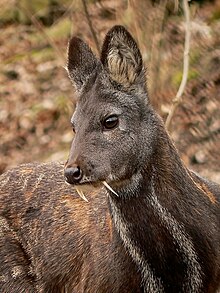Moschus moschiferus
| Siberian musk deer | |
|---|---|
 |
|
| Moschus moschiferus | |
| Scientific classification | |
| Kingdom: | Animalia |
| Phylum: | Chordata |
| Class: | Mammalia |
| Order: | Artiodactyla |
| Family: | Moschidae |
| Genus: | Moschus |
| Species: | M. moschiferus |
| Binomial name | |
|
Moschus moschiferus Linnaeus, 1758 |
|
 |
|
| Range of the Siberian musk deer | |
The Siberian musk deer (Moschus moschiferus) is a musk deer found in the mountain forests of Northeast Asia. It is most common in the taiga of southern Siberia, but is also found in parts of Mongolia, Inner Mongolia, Manchuria and the Korean peninsula.
Their small shape allows them to hide from predators through tiny openings in the rocky terrain and also allow them to run exceptionally fast from their predators. Although bearing fangs, Siberian musk deer are actually herbivores with their main source of nutrients, lichens.
Due to the severe amount of poaching for its musk gland, meat and deforestation, the deer population is continuing to decrease. It is expected that the population will be reduced to at least 30% over the next three generations. However, efforts from each sighted countries are beginning to reintroduce the musk deer’s population.
Siberia , North Mongolia , Russia , North China and Korea - M. m. moschiferus
Russian Far East - M. m. turovi
Verkhoyansk Ridge - M. m. arcticus
Sakhalin - M. m. sachalinensis
Korea - M. m. parvipes
It takes approximately a year for the Siberian musk deer to reach maturity with an average deer to live at least 10 – 14 years.
During breeding season, male deer will grow fangs instead of antlers. These fangs are used to compete with other males and attract females. Fangs that are longer and stronger creates a more intimidating stance and becomes more attractive to females as the offspring of that male are likely to become healthier and fit.
Once the male and the female deer have procreated, the females will become pregnant lasting over 6 months and can give birth to 1-3 offspring, usually between the months of May through June.
...
Wikipedia

